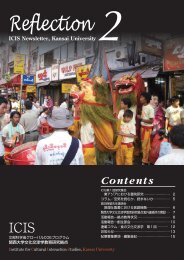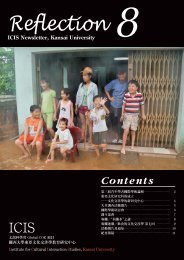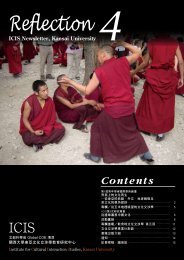English
English
English
Create successful ePaper yourself
Turn your PDF publications into a flip-book with our unique Google optimized e-Paper software.
ICIS Newsletter, Kansai University<br />
Part 6<br />
Kopi-tiam (Coffee Shop) Conveys<br />
the Culture of Gourmet Foods<br />
HUANG Yun (COE-PD, ICIS, Kansai University)<br />
The cheap and enjoyable restaurants known as “Kopi-tiam” and<br />
“Hawker Centre” are the most appropriate places for tasting local<br />
food at a reasonable price in multi-ethnic countries such as Singapore<br />
and Malaysia. These two countries are the model examples of<br />
economic development among the Southeast Asian countries. There<br />
are also many high-class restaurants, but for those who want to<br />
appreciate the local food and culture, “Kopi-tian” and “Hawker-<br />
Centre” would be the best choices.<br />
“Hawker Centre” is a kind of street food market where there are<br />
many types of food stalls serving various foods such as noodles. They<br />
mainly sell the most popular Chinese foods, as well as the Malaysian<br />
dish “Laksa” (noodles made from rice)and “Nasi Lamek” (a<br />
Malaysian indigenous rice dish). “Kopi-tiam” is a similar kind of<br />
food market, but it is smaller in scale than “Hawker Centre”. “Kopi”<br />
means coffee in the Malaysian language and “Tiam” means shop in<br />
the Fujian dialect. Literally, it means coffee shop. But it is not quite<br />
what we would normally imagine from the expression, coffee shop.<br />
“Kopi-tiam” is the product of the unique food culture of Singapore<br />
and Malaysia, and it can be thought of as the means to convey the<br />
local food culture and its history.<br />
The most attractive point of “Kopi-tian” is its low price. In<br />
Singapore, a meal is available for between approximately 2.5 SGD<br />
(170 JY)and 5 SGD (330 JY). There is a wide variety of choices,<br />
from Fujian noodles to Chaozhou style porridge. (See photo 1)<br />
“Kopi-tiam” originally started by selling breakfast, the typical<br />
Photo 1<br />
breakfast being a slice of toasted bread and coconut margarine, egg,<br />
and a cup of coffee for 2 SGD (130 JY). The local coffee, called<br />
“Kopi-o”, is generally black coffee.<br />
Just as Chachanteng represents local gourmet foods in Hong Kong,<br />
“Kopi-tiam” began in Singapore and Malaysia as local food courts,<br />
reflecting the distinctive style of food and drink.<br />
Photo 2<br />
People who want to enjoy a leisurely meal with friends, as well as old<br />
people who spend long hours in the afternoon chatting with their<br />
acquaintances, are the ever-present scenery at “Kopi-tiam”. Local<br />
businessmen who wish to meet for talks outside of their offices—as<br />
per local social customs—may also choose to go to “Kopi-tiam”. In<br />
“Kopi-tiam”, anyone can experience the casual relaxed atmosphere of<br />
the South Sea countries, where time seems to be floating along<br />
slowly. (See photo 2)<br />
As “Kopi-tiam” was born within the social environment of<br />
Singapore and Malaysia, its food culture and style are somewhat<br />
related to those of ethnic Chinese people in these two countries. It is<br />
not clear exactly when the Chinese, who came south from China,<br />
began to prefer coffee, but it is likely that the custom arose gradually<br />
out of the British colonial period. The business practice of serving<br />
various sorts of foods and drinks in one place under the concept of<br />
“coffee” can be regarded as the first step in the localization of the<br />
ethnic Chinese, whose ethnic Chinese culture has come to form a<br />
distinctive part of contemporary Singapore and Malaysia.<br />
Moreover, “Kopi-tiam” reflects the politics and ethnic relations in<br />
both countries. In Singapore “Kopi-tiam” means food stalls run by<br />
Chinese, while in Malaysia it indicates a coffee shop for Chinese. But<br />
even if the other ethnic group does not participate in the Kopi-tiam<br />
business, the fact that Chinese also prepare Malaysian foods – such as<br />
Laksa – shows a merging of the food culture of Malaysia, which is a<br />
kind of cultural interaction in itself.<br />
Photo 1:Food served in Kopi-tiam<br />
Photo 2:People enjoying conversation at “Kopi-tiam”<br />
9












